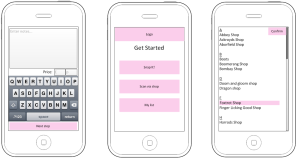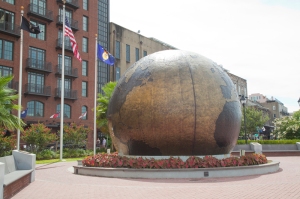Back to digital stuff this week. We’ve recently been working on a couple of app projects for release in the coming months and so I thought I would share a few of our learnings on the process. I’ve previously written about mobile and apps and specifically about the considerations when thinking about developing an app, but today I thought I would look at the specifics of the next stage – getting it to development.
Having worked in website and application development (in the IT sense) for many years, the process of design – development- test – release is one that is ingrained. But when it comes to app development there are some key nuances that should be considered. In generating the ideas for the two projects we have recently worked on, first we tested the ‘need’ against some key questions:
- Does the process you are building live by itself?
- Do your users need to be able to do it offline or do they need internet access?
- Does it require features from the mobile device / does it require being ‘mobile’ in order to work?
- Does the app provide a solution for a genuine need?
Additionally, the question that was in my mind is “will it have appeal?” Ultimately is the idea either useful enough or fun enough that people will want to use it? In the case of both our apps I wrote a small mandate and business case for the app, to test the concept. This provided the key foundation for specification as it set out the core reasons why the app should exist – which in turn become the core functional considerations for the app and the design.
In the case of our apps we started by keeping with traditional methods. I wireframed the user journeys and functionality for the app so that we could test the journey. Using the wireframes we created a crude clickable prototype and tested this with a couple of people to see if it not only made sense but that it achieved all that was intended.
Feedback is key in app development, because the general principle for apps is that they should be intuitive. Keeping them as simple as possible is absolutely key if the app is going to be used.
When we were satisfied with the general specifications for the app it was time to apply a graphical design. There are plenty of templates available on line, we opted for a Photoshop based one. Again a key thing we discovered is knowing what the personality of the app is going to be before entering into the design phase. Also, doing research into the standards required for interface design is crucial. Apple have specific interface design guidelines, for example, that should be adhered to if you want your app to be approved. Also, think about the tasks your app is going to allow users to do and design the interface elements to suit this. If you want it to be playful then consider movement and transition, but if you want it to be formal and task driven then make things logical and as simple as possible. Consistency is a key consideration though, if you take an approach on one screen then try to make the rest of the app screens follow the same lines. This will help users to orientate themselves in the app and intuitively understand how it works, without instruction.
For our apps we had two very different personalities. The first is a Christmas related app for a local town so the design needed to reflect this. A nighttime scene with snow effects were the design concept. The second is a comical app related to a well known region of the country and so we created a character to reflect this. In both cases the general approach was then reflected throughout the app for consistency. At this point it is also necessary to make decisions on what platforms you are going to support, as each has different screen sizes. Designing for an iPhone 5 screen could mean that it won’t fit onto a smaller Android screen, so make sure you factor this in when designing. Another thing that it is worth considering is utilizing the existing style for the platform. If the ‘out of the box’ Apple style for certain things works with your design, then don’t over complicate it by designing something custom. Don’t forget, the users are already used to the existing standards so don’t mess with them.
When it comes to development, if you don’t have a resource available to you then planning who is going to do this work for you is something not to be taken lightly. There are plenty of dev houses available all over the world, but knowing you are going to get what you want is the difference between spending lots of money and getting value for money. In our case, we approached 3 agencies and asked them to quote. We prepared annotated designs and non-functional requirements for our app and asked them all to respond accordingly and then made a decision based on the detail, cost, timescales and approach. There are plenty of very reputable agencies based in India, Pakistan and eastern Europe that can supply very cheap development services, or you can get a freelancer. If you do go with a freelancer though, understand you are not protected by a company constitution so try and agree some sort of contract and scope of work to be delivered for a fixed cost. Time and materials will cost you more. Finally, make sure you have some way of tracking progress with them. We use an online tool called Zoho, so that we can see their progress and the tasks they are undertaking.
When it comes to development another key thing to make sure you agree with your development supplier is that you own the intellectual rights and code for the development. You don’t want them to own the right to do anything with the app. Making sure they develop using your Apple developer account / Google App account is also a good way to make sure you have control. Don’t forget that if you are going to charge for you app then it is the account the app has been built with that will collect the money!
So, your app is well thought through, planned, designed and your developers are beavering away. It’s all done surely? No…make sure that once the app is available for testing that you not only rigorously test it yourself in the context it is going to be used, but also get other people to try it out as well. Validating that it actually works for a normal user and isn’t confusing or clumsy will mean you get good reviews rather than bad ones in the app stores. Also make sure that they specification has been delivered correctly and if it hasn’t, get them to fix it. You’ve paid for a job to be done properly so make sure you get what you paid for. This is where dealing with a freelancer can be tricky!
So finally, once it is launched the final consideration is getting it out there. Make sure that you have a marketing plan for your app because if you don’t it will be easy for your app to just disappear into obscurity. A few key things to consider are:
- Give free promo versions to influential social users and bloggers (and celebs if you can, they have huge amounts of lemming like followers) – Apple gives you 50 free promo codes for each release so use them wisely
- Support your app with a social media and/or web presence – having a supporting promotional web page and/or social media page will mean getting the message out to those who don’t scour the app stores
- Tie in additional products – if the app is fun then think about creating additional products to support it, such as t-shirts, mugs and posters.
- If your app serves a particular type of person or business then target them directly, pushing the benefits. Even go and show them how it works if you can or produce a brochure to sell the product to them.
Last thoughts…allow plenty of time. A well planned app, even a simple one, is going to take at least 6 months to get to market. Also, don’t worry about getting the app 100% right on the first release and certainly don’t fill it with every piece of functionality you can think of. Simplicity is the key so start by just serving the key need you identified. You can then use the users to tell you how to develop the app if it is successful. For me, developing our first apps has been a lot of fun so try and have fun when going through the process as well. Enjoy!




